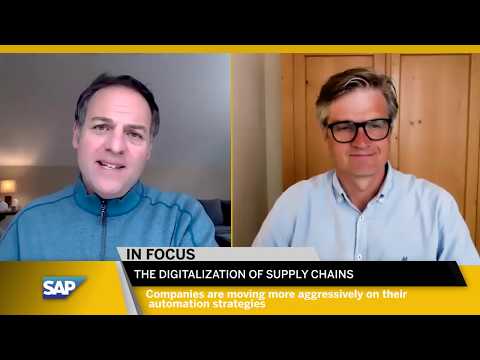Failure often provides the toughest and most important of life’s lessons, and the world was dealt a particularly hard lesson when supply chains failed as the novel coronavirus pandemic took hold.
According to Franz Hero, head of SAP Digital Supply Chain Development, “One good thing about a crisis is it focuses the senses on things that are really important. I think everybody understands now – you, me, and every consumer – what it means if a supply chain is broken.”

As COVID-19 began making its way beyond China, consumers started buying supplies of toilet paper, soap, flour, and pasta as it became clear that people would be forced to stay at home inquarantine. Stores quickly ran out of supplies and some imposed limits on the quantities
How have SAP Digital Supply Chain customers adapted?
“I talked to a customer, they produce pasta,” Hero says. “Reacting to demands, they said ,‘Okay, we don’t care anymore whether it is spaghetti or a different type of pasta. One production line, one kind of pasta, 24/7.’ Another company that manufactures chemicals wanted to increase production but ran out of shipping containers – all the empty containers were in China. All of these companies have something in common – they have to react very quickly either to changing demand situation or changing supply situation.”
The challenge, highlighted in a recently published Oxford Economics study, is how to make supply chains more resilient.
This means building redundancies into a supply chain and being able to source from multiple suppliers and adopting localization strategies, putting tools and manufacturing where the consumers are. SAP Ariba software can help companies with these issues, but this will only work well if companies build an organization and business processes designed for changes.
Hero says planning, forecasting, and supply network tools can all help, but that companies also need to bring synchronized planning into the execution areas like manufacturing and logistics.
“SAP Integrated Business Planning, one of our earliest in-house developed cloud solutions, allows companies to forecast the demand based on different input parameters from sales, from history, from point-of-sale data, and so forth,” he says. It can simulate different scenarios helping a company’s manufacturing and logistics operations respond quickly and in a coordinated fashion to changing circumstances.
Accelerating Automation with Industry 4.Now
Hero suggests that one outcome of the global pandemic is that companies will move more aggressively on their automation strategies, including Industry 4.0 (IoT) plans, in order to improve resilience.
“The automation of the plant and integration with everything – from manufacturing execution systems, the maintenance systems, quality management systems, and of course also the logistics, the in-house logistics, warehousing and transportation,” has become a priority, according to Hero.
“Then there’s also the environment, employee health and safety – that’s currently the big discussion as countries look to return to work,” he says.
These topics were already in discussion before the coronavirus, with McKinsey & Company reporting in July 2019 that 68 percent of companies ranked Industry 4.0 as a top priority. In anticipation of this, SAP launched the board-sponsored Industry 4.Now program last year. The program is designed to support customers with the vertical integration of the applications needed to automate a plant and integrate these applications and automation technology into supply chain processes.
“We can connect the sensors to the robots, everything you need really to automate these business processes,” Franz Hero says. “Companies are looking at these projects and measuring them against the employee safety aspects that have arisen with this pandemic. These projects are becoming a priority and we’re here to make them happen.”
Traditionally, the task of a supply chain manager was to provide acceptable service levels while minimizing costs. This has been shifting in recent years as supply chains have become a key differentiator among companies because customer demand is growing. SAP has introduced three key offers for customers designed to enable improved data-driven decision-making, greater collaboration, and resilience to help ensure supply chains remain unbroken for 90 days.
- Supply chain visibility: SAP Integrated Business Planning customers have access to specific functionalities of SAP Supply Chain Control Tower, enabling them to gain quick visibility into supply chain issues, conduct impact analysis, and orchestrate responses.
- Freight collaboration: SAP Transportation Management customers have access to the freight collaboration capabilities of SAP Logistics Business Network to connect with alternate logistics service providers to reduce constraints and freight costs.
- Supply chain planning as a service: The partner ecosystem can use SAP Integrated Business Planning to provide planning as a service to companies, thereby helping companies more quickly and frequently eliminate bottlenecks, match demand with supply, and better serve customers.



